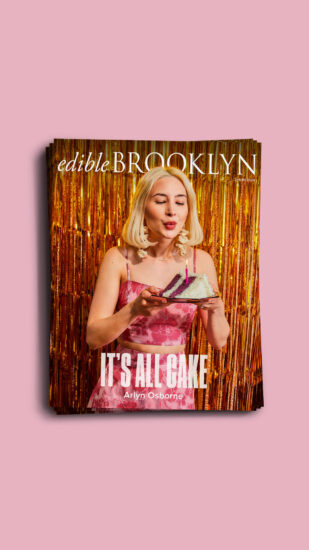
You’d think a seafood obsessive like Sean Dixon would have a cute nautical backstory. Something like “I joined my parents on a sailing trip around the globe” or “I was only 4 when I discovered lobster.” But Dixon grew up in Buffalo, far from the ocean’s siren song. He was the landlubber son of a math teacher and electrician. Also: he’s highly allergic to seafood.
“I honestly can’t tell you why I became so focused on this one thing,” Dixon smiles. “Maybe I was just, ah, born this way?”
You see, Dixon has staked his life’s work around aquatic life, as the affable co-creator of Village Fishmonger (like a CSA, but for seafood) and co-founder of Sustainable Seafood Week that returns to New York on June 21 (see the full line-up here). He’s also an attorney for Riverkeeper, the powerful watchdog tasked with protecting the Hudson River and NYC’s drinking water supply.
First and foremost, Dixon’s priority is sparking interest among New Yorkers in the water that surrounds them. Despite the confluence of rivers, bays, inlets and the vast ocean beyond, city-dwellers have a tendency to focus on their concrete-and-chrome, land-locked existence.
“I’ve met people who’ve lived here their entire lives, who are surprised to find out [Manhattan] is an island,” Dixon says, shaking his head slowly. “Sometimes you don’t see what’s right in front of you.”
That selective blindness can extend to the plate as well. For a city so enamored with its sushi, its ceviche, its dollar oyster happy hours, there is certainly a disconnect. New Yorkers may love seafood, but how does that love relate to the actual sea?
Dixon wants to bridge the disconnect, to show urban eaters there is a thriving edible ecosystem right offshore. He may not be able to eat seafood himself — a cruel irony to be sure — but he can use it as a way of engaging people, of making our waterways tangible and important.
Seafood not your thing? Maybe it’s kayaking, swimming, even surfing. Dixon knows guys who surf off the Rockaways; he encourages them to wear their wetsuits on the subway. He thinks they could impact New Yorkers who never knew surfing was an option. “I feel like everyone has an ‘in,’ some way of convincing them to engage with the ocean,” says Dixon.
Certainly seafood makes a great entry point for many. That was a major motive in starting Village Fishmonger — making a direct connection between New York home cooks and the men and women who provide their seafood. The business started small but has swelled now to some 8-900 members.
And Sustainable Seafood Week, launched only three years back in New York, is a runaway hit; events regularly sell out, and it has now spread to four other cities. But why does this matter? What are the real-world effects of mobilizing an ocean-savvy populace?
Dixon has an easy answer to these hypotheticals: An aware citizenry makes smarter choices. On the micro level, this can be as simple as not tossing a cigarette butt in the storm sewer because you know the harm it can cause an aquatic ecosystem. But on a grander scale, people can be spurred into even larger actions.
Take the Empire Dragon Boat Club, a group of female boating enthusiasts who happen to all be cancer survivors. Dixon says these women started to look into pollution around Queens’ waterways; they’re now part of the Guardians of Flushing Bay, a group dedicated to improving water quality around LaGuardia Airport.
“It’s when you get out there and start looking at the water that everything changes,” says Dixon. “Once you start noticing, you don’t stop.”
And certainly there’s an ocean’s worth of work still to be done, both physical and educational. Cleanup efforts in New York’s harbors have been hugely impressive, restoring conditions to long-disappeared levels of vitality. Marine and aquatic life is coming back in every bay, on every beach, and in each new migration season. You can now see whales, sea lions, ospreys, horseshoe crabs, even endangered sturgeon. (And of course, let’s not forget the oysters.)
Still, a quick stroll along the Gowanus Canal or Newtown Creek will make it eminently clear: the situation remains dire. Decades of industrial pollution and human sewage have incubated a quagmire of filth; it will be many decades before some waterways will be remotely clean or safe.
And while Dixon would like people to understand how much improvement we’ve made — and how safe, locally sourced seafood is very much a reality — he also thinks New Yorkers could be better educated about potential dangers. Like, maybe you shouldn’t be fishing in Gowanus, or taking a dip in Newtown? “I think some people don’t even know what a Superfund site is,” Dixon says.
We’ll all be educated soon enough, if Dixon has his way. This tireless educator/litigator/fishmonger seems to have boundless energy for his cause. And really, perhaps his origin myth is beyond the point. When New York’s waterways have found such a dynamic and tireless advocate, do we really need to know why he cares so much?
Dixon’s mother was recently cleaning out their old attic; she found some drawings he’d made as a child. Surprise surprise — it was a bunch of pictures of fish. “Even then, I knew what I liked,” he laughs.


